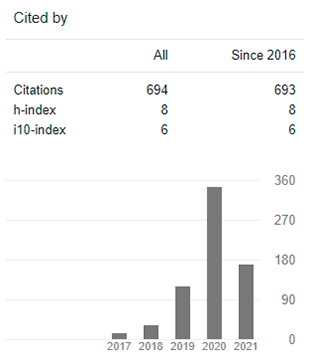Error Analysis of Generating Compound Sentences in Undergraduate Students’ Writing
Análisis de Errores en la Generación de Oraciones Compuestas en la Escritura de Estudiantes Universitarios
DOI:
https://doi.org/10.29394/Scientific.issn.2542-2987.2024.9.33.1.23-44Keywords:
error analysis, compound sentences, english writing, linguistic interference, pedagogical strategiesAbstract
This study analyzed errors in generating compound sentences in the writing of 26 university English students. A qualitative-descriptive methodology was employed, collecting data through a writing task where participants had to form five compound sentences based on a provided image. The analysis focused on sentence fragments and run-on sentences, following the steps proposed by Corder (1975). Results revealed that out of 128 written sentences, 60 contained errors. The most frequent error was fused sentences (75%), followed by subject omission (18,33%). Other errors included verb omission, lack of subject and verb, and comma splices. These errors were mainly attributed to mother tongue interference and lack of understanding of English grammatical structures. The study concludes that students have significant difficulties with punctuation and compound sentence structure, suggesting the need for pedagogical strategies focused on improving these areas. The findings can contribute to the development of more effective teaching plans to strengthen grammatical and writing skills in english.
Downloads
References
Andrews, R., Torgerson, C., Beverton, S., Freeman, A., Locke, T., Low, G., … Zhu, D. (2006). The effect of grammar teaching on writing development. BERJ. British Educational Research Journal, 32(1), 39-55, e-ISSN: 0141-1926. Retrieved from: https://doi.org/10.1080/01411920500401997
Astrini, N., Ratminingsih, N., & Utami, I. (2020). The model of strategies employed by English teachers in teaching writing skill in national plus schools. Journal of Educational Research and Evaluation, 4(1), 59-62, e-ISSN: 2549-2675. Retrieved from: https://doi.org/10.23887/jere.v4i1.23682
Carroll, R. (1990). Student Success Guide: Writing Skills. United States: International Copyright Law.
Corder, S. (1975). Error Analysis, Interlanguage and Second Language Acquisition. Language Teaching & Linguistics: Abstracts, 8(4), 201-218, e-ISSN: 0306-6304. United Kingdom: Cambridge University Press.
Craiker, K. (2022a,b). Independent clause: What it is explained with examples. United States: Orpheus Technology, prowritingaid.com.
Deviyana, V. (2017a,b,c). Students’ grammatical errors in using coordinate conjunction in compound sentences writing at smpn 1 wonosobo in the first semester of the eighth grade in the academic year of 2017/2018. A Thesis. Indonesia: Universitas Islam Negeri Raden Intan Lampung.
Erdoğan, V. (2005). Contribution of error analysis to foreign language teaching. Mersin Üniversitesi Eğitim Fakültesi Dergisi, 1(2), 261-270, e-ISSN: 1306-7850. Turkey: Mersin University.
Fadhilah, S. (2022). Students’ problems in writing compound sentences. English Language Education and Current Trends (ELECT), 1(1), 53-62, e-ISSN: 2830-5655. Retrieved from: https://doi.org/10.37301/elect.v1i1.35
Grammarly (2023). FANBOYS: Coordinating Conjunctions. United States: Grammarly, Inc.
Güneş, S. (2013). An analysis of recognition of extended compound sentences. IOJET. International Online Journal of Education and Teaching, 1(1). 25-37, e-ISSN: 2148-225X. Türkiye: Informascope.
Hendrawati, N. (2018a,b). An analysis on students’ errors in writing sentence patterns. Loquen. English Studies Journal, 11(01), 63-85, Indonesia: Universitas Islam Negeri Sultan Maulana.
Johns Hopkins (2021a,b). Sentence Fragments. United States: Johns Hopkins University.
Khansir, A. (2012). Error Analysis and Second Language Acquisition. Theory and Practice in Language Studies, 2(5), e-ISSN: 1027-1032, e-ISSN: 1799-2591. Retrieved from: https://doi.org/10.4304/tpls.2.5.1027-1032
Knapp, P., & Watkins, M. (2013). Genre, Text, Grammar: Technologies for Teaching and Assessing. TESL-EJ. Teaching English as a Second or Foreign Language, 17(2), 1-3, e-ISSN: 1072-4303. United States: Editorial Board TESL-EJ.
Krahn, A. (2014). A New Paradigm for Punctuation. Theses and Dissertations. United States: University of Wisconsin.
Kwiatkowski, V. (2024). Comma Splice - Rules, Examples & Practice Sheet. Alemania: BachelorPrint.
MacArthur, J. (2013a,b). Commas with Conjunctive Adverbs. United States: American Journal Experts, LLC.
MasterClass (2021a,b,c). Definition and Examples of Coordinating Conjunctions. San Francisco, CA., United States: MasterClass.
Murtiningsih, S., Kurniawati, S., & Putri, A. (2022). University EFL students’ grammar mastery and their writing ability: A quantitative study. In Proceedings of the International Conference on Sustainable Innovation on Humanities, Education, and Social Sciences (ICOSI-HESS 2022). (pp. 226-236). Paris, France: Atlantis Press.
Puspa, F. (2019). An error analysis on compound complex sentence of the students’ english education department of the state institute islamic studies of metro in the academic year 2017/2018. Undergraduate Thesis. Indonesia: State Islamic Institute of Metro (IAIN Metro).
Rahma, A., & Noor, R. (2021). An Analysis on Students’ Ability in Using Compound-Complex Sentences in Writing a Short Essay. Journal of English Language Teaching, 10(1), 53-60, e-ISSN: 2302-3198. Indonesia: Universitas Negeri Padang.
Ramdhianti, A., Kurniasih, E., Somba, S., & Akmaliah, N. (2022). An error analysis in generating compound complex sentence on students’ writing. JELTL. Journal of English Language Teaching and Literature, 5(2), 141-150, e-ISSN: 2622-9056. Retrieved from: https://doi.org/10.47080/jeltl.v5i2.2131
Sacal, P., & Potane, J. (2023). Students’ Mastery of English Grammar towards Effective Writing and Speaking Competence. International Journal of Multidisciplinary: Applied Business and Education Research, 4(8), 2894-2904, e-ISSN: 2774-5368. Retrieved from: https://doi.org/10.11594/ijmaber04.08.27
Sapkota, A. (2012). Developing Students’ Writing Skill through Peer and Teacher Correction: An Action Research. Journal of NELTA, 17(1-2), 70-82, e-ISSN: 2091-0487. Retrieved from: https://doi.org/10.3126/nelta.v17i1-2.8094
Sari, E., Gustiani, S., Yusri, Y., & Simanjuntak, T. (2022). An Error Analysis of English Sentence Construction in Writing Subject. In Proceedings of the 5th FIRST T3 2021 International Conference (FIRST-T3 2021). (pp. 20-27). Paris, France: Atlantis Press.
Sari, I., Syarif, H., & Amri, Z. (2019a,b,c,d). An Analysis of Compound Sentences in Students’ Writing. In Proceedings of the Seventh International Conference on Languages and Arts (ICLA 2018). (pp. 341-348). Paris, France: Atlantis Press.
Sattayatham, A., & Ratanapinyowong, P. (2008). Analysis of Errors in Paragraph Writing in English by First Year Medical Students from the four Medical Schools at Mahidol University. Silpakorn University International Journal, 8, 17-38, e-ISSN: 1513-4717. Thailand, Asia: Sillpakorn University.
Shweba, A., & Mujiyanto, Y. (2017). Errors of Spelling, Capitalization, and Punctuation Marks in Writing Encountered by First Year College Students in Al-Merghib University Libya. English Education Journal, 7(2), 93-103, e-ISSN: 2502-4566. Indonesia: Universitas Negeri Semarang.
Sudhakar, M., & Farheen, S. (2015). The Importance of Grammar in English Language Teaching. International Journal of Scientific Research, 4(8), 122-124, e-ISSN: 2277-8179. India: World Wide Journals, PVT. LTD.
Suliman, F., Ben-Ahmeida, M., & Mahalla, S. (2019). Importance of Punctuation Marks for Writing and Reading Comprehension Skills. Faculty of Arts Journal, 13, 29-52, e-ISSN: 2664-1682. Retrieved from: https://doi.org/10.36602/faj.2019.n13.06
Sundari, D., Hidayah, J., Edy, S., & Esmianti, F. (2021). Error Analysis of English Sentence Structure in Students’ Written Paragraphs. ENGLISHFRANCA. Academic Journal of English Language and Education, 5(1), 37-60, e-ISSN: 2580-3689. Retrieved from: https://doi.org/10.29240/ef.v5i1.2173
The Albert Team (2022). Independent Clauses: Definition, Examples, & Exercises. United States: Learn By Doing, Inc.
Wahyana, A. (2020). Error Correction: Is it necessary and beneficial?. Salatiga, Indonesia: Universitas Kristen Satya Wacana.
Hernández-Sampieri, R., & Mendoza, C. (2018). Metodología de la investigación. Las rutas cuantitativa, cualitativa y mixta. ISBN: 978-1-4562-6096-5. Ciudad de México, México: Editorial McGraw-Hill Education.
Published
How to Cite
Issue
Section
License
Copyright (c) 2024 INDTEC, C.A.

This work is licensed under a Creative Commons Attribution-NonCommercial-ShareAlike 4.0 International License.
The content of the journals of this site, are under a Creative Commons Attribution-Noncommercial-Share Alike 4.0 International License.













